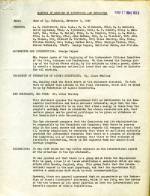|
Who was going to control the A-Bomb, make decisions about its development and use?
The US government, of course, was the immediate answer, but which part of the government?
The military had overseen the development of the new weapon during the war, and General
Leslie R. Groves intended to keep the military as far as possible in control of its
future. He helped the War Department draft a bill that would put the atomic program
under the direction of a nine-member panel of military men and civilians. While the
bill, introduced to Congress under the names of its sponsors as the May-Johnson Bill,
seemed reasonable enough, the atomic scientist’s discussion groups quickly became
convinced that it would make it easy for the military to effectively control the outcome
of the panel’s deliberations, putting the A-Bomb under de facto military control.
The discussion groups began to communicate with each other, sharing information, and
mobilizing in favor of civilian control and in opposition to May-Johnson.
Caltech, too, had a discussion group. They started meeting in the basement of the
Athenaeum, Caltech’s faculty club, soon after Hiroshima, discussing like the others
issues of atomic weaponry and the threat posed to the world. They organized themselves
as the Association of Pasadena Scientists, a group whose purpose it was "to meet the
increasingly apparent responsibility of scientists in promoting the welfare of mankind
and the achievement of a stable world peace." Many of the members and the group’s
first leaders were members of Pauling’s laboratory; Pauling himself often attended
meetings. The May-Johnson bill became a focal point for discussion as the researchers
weighed the pros and cons of the military’s role in overseeing atomic weapons. The
group quickly decided to oppose May-Johnson. Fuel for their cause came in November
1945 when some overzealous US military officials in Japan tore apart five Japanese
research cyclotrons (atom smashers) and threw the pieces into the sea. When it became
clear that the machines had been used for strictly nonmilitary purposes, the incident
served to further convince scientists in the US that the military did not know the
first thing about pure research into the atom. Opposition to May-Johnson increased.
|
|
Click images to enlarge

Minutes from a meeting of Pasadena-area scientists and educators. November 9, 1945.

Letter from Linus Pauling to Frank Aydelotte. November 16, 1945.
"[May-Johnson is] the first totalitarian bill ever written by Congress. You can call
it a Communist bill or a Nazi bill, whichever you think is worse."
|

